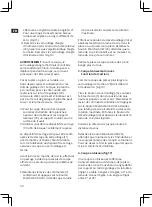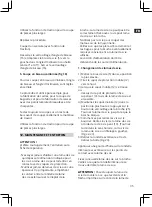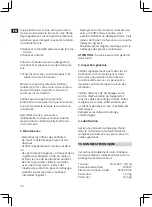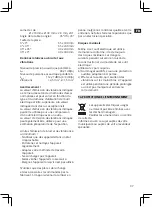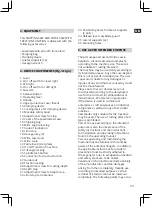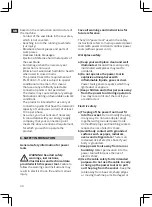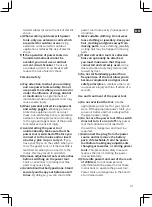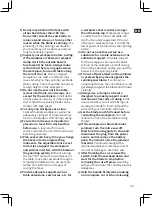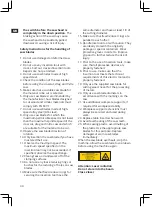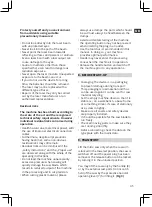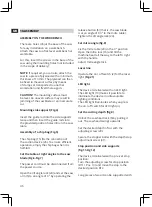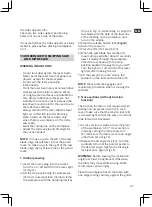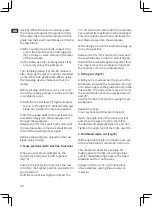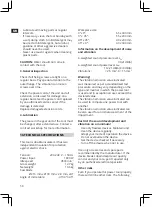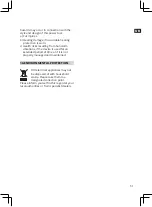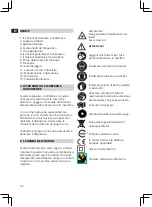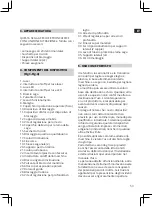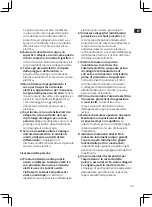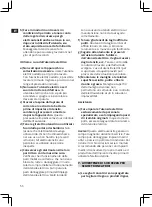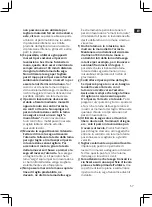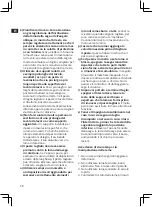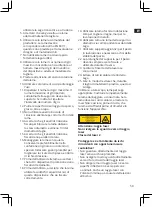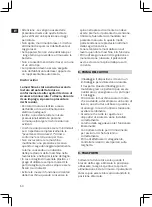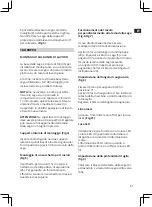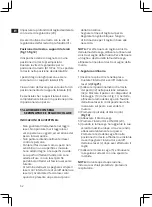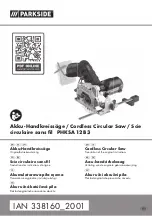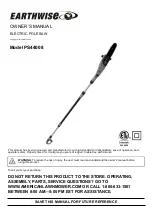
48
rail (18). When the board is arched, place
the convex side against the guide rail (18).
If the inwardly curved side is placed at the
guide rail, the board could break and clamp
the saw blade.
3) When sawing long boards, support the
end of the board with the side supports
(35), a trolley or work surface at the level
of the saw table.
4) If possible, use the clamping device (10)
to securely clamp the workpiece.
The clamping device (10) can be removed
after opening the lock (11) and be mounted
on the other side of the table. When using
the clamping device, make sure that it is
locked.
Before turning on the saw, carry out a dry
run of the sawing process to make sure that
no problems occur.
5) Hold the control lever (7) tight and press
the on / off switch (23). Wait until the saw
blade has reached its maximum speed.
Press the release switch (34) and lower the
saw blade slowly into the workpiece and
through the workpiece.
Release the ON / OFF switch (23), wait until
the saw blade has come to a standstill and
then lift the saw blade once again.
Remove the workpiece only when the saw
blade stops moving.
3. Cross-sections (with traction function)
When you saw broad workpieces, the
traction lock (28) must be first opened.
(Fig.19)
Pull out the locking knob (6), raise the saw
arm (5) to the highest position and slide it in
your direction.
Hold the control lever tight and press the
on / off switch (23). Wait until the saw blade
has reached its maximum rotational speed.
Press the release switch (34) and lower the
saw blade slowly onto the workpiece.
While doing so, push the saw head away, up
to the stop position.
Release the ON / OFF switch (23), wait until
the saw blade has come to a standstill and
then lift the saw blade again only after that.
You may remove the workpiece only when
the saw has come to a complete stop.
4. Tilting cut (Fig.17)
A tilting cut is made across the grain of the
workpiece, whereby the saw blade is found
at a certain angle to the guide rail and to the
mitre table. The mitre table is set at 0° and
the saw blade is set at an angle between 0°
and 45°.
Use the traction function for sawing broad
workpieces.
Repeat the steps.
Cross sections (with traction function).
Open the angle lock of the mitre saw (16)
and move the saw arm (5) to the left to
the desired tilt angle (between 0° and 45°).
Tighten the angle lock of the mitre saw (16).
5. Combined mitre cut (Fig.18)
Mitre angle and angle of inclination are set
at the same time for combined mitre cuts.
This method is used, for example, for
making picture frames, for cutting strips
and for manufacturing boxes with sloped
sidewalls and for roof trusses.
Always test the cut on a remnant piece
of wood before cutting the actual work
material.
UK
Summary of Contents for 210.200.356
Page 2: ...2 7 1 5 23 14 12 31 30 22 24 19 32 11 13 16 10 27 28 29 26 15 9 35 33 18 36 21 1 ...
Page 3: ...3 7 2 4 8 6 17 2 3 4 25 34 32 35 33 ...
Page 4: ...4 15 26 18 13 18 29 29 31 30 30 16 19 20 22 21 6 5 7 9 11 6 8 10 12 ...
Page 5: ...5 27 28 1 3 10 11 13 15 17 19 14 16 18 20 ...

